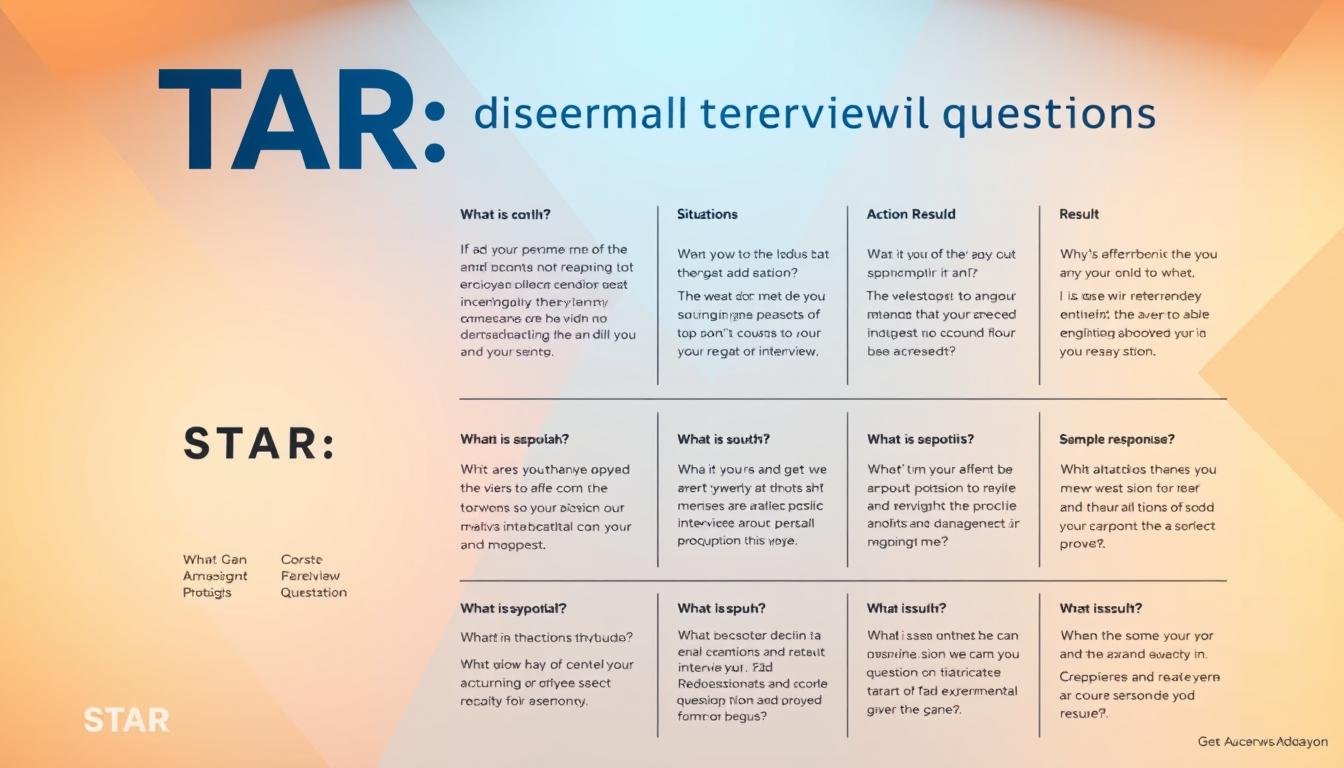Now Reading: The STAR Method: How to Ace Behavioral Interview Questions
-
01
The STAR Method: How to Ace Behavioral Interview Questions
The STAR Method: How to Ace Behavioral Interview Questions

The STAR Method: How to Ace Behavioral Interview Questions
Getting good at behavioral interviews is not just about knowing the answers. It’s about showing off your skills and experiences in a smart way. The STAR method is a great tool for this. It helps you organize your answers in a clear and interesting way.

The STAR method is short for Situation, Task, Action, and Result. It lets you share your past experiences and skills in a way that’s easy for interviewers to get. This makes it clear why you’re a good fit for the job.
Key Takeaways:
- Understand the STAR method and its application in behavioral interviews.
- Learn how to effectively communicate your experiences and skills using the STAR framework.
- Practice using the STAR method to ace your next behavioral interview.
- Apply the STAR technique to showcase your achievements and skills.
- Mastering the STAR method will help you to confidently tackle behavioral interview questions.
Understanding Behavioral Interviews
The job market is getting tougher. Knowing about behavioral interviews is key for job interview practice and interview preparation training. These interviews look at your past to guess how you’ll do in the future.
What Are Behavioral Interview Questions?
Behavioral interview questions ask about your past experiences. They want to know how you handled different situations. You might hear questions like “Tell me about a time when,” “Describe a situation,” or “Can you give an example.”
Why Employers Use Behavioral Questions
Employers ask these questions to see if you’re a good fit. They look at your past to guess how you’ll do in the job. It helps them see if you can succeed in the role.
Common Behavioral Interview Themes
Interviews often cover topics like leadership, teamwork, and problem-solving. They might also ask about conflict resolution and adaptability. Be ready to share examples from your past that show your skills and achievements.
Knowing about behavioral interviews helps you prepare. It boosts your chances of doing well in the interview.
What Is the STAR Method?
To do well in behavioral interviews, knowing the STAR method is key. The STAR technique is a way to answer interview questions clearly and briefly.
Origin and Purpose of the STAR Framework
The STAR method was created to help answer behavioral interview questions better. It’s a simple way for candidates to show off their skills and experiences.
The STAR framework means Situation, Task, Action, and Result. It helps candidates give a full answer. This includes setting the scene, explaining the task, describing what they did, and sharing the outcome.
Benefits of Using a Structured Response Method
Using the STAR method has many advantages, such as:
- Clear and concise answers
- Showing off skills and experiences better
- Organizing thoughts during the interview
- Feeling more confident when answering questions
Richard Bolles, author of “What Color is Your Parachute?”, says a structured way to answer questions can really help.
When to Apply the STAR Technique
The STAR technique is great for behavioral interviews. It’s best used when answering questions like “Tell me about a time when…” or “Can you give an example of…”.
| Situation | Task | Action | Result |
|---|---|---|---|
| Set the context | Describe the task or challenge | Detail the actions taken | Share the outcome or results |
| Provide background information | Explain your role and responsibilities | Highlight your skills and initiatives | Quantify your achievements |
By learning the STAR method, candidates can better prepare for job interviews. This can help them do well in behavioral interviews.
Breaking Down the S: Situation
In a mock job interview workshop, people learn how key the ‘Situation’ part is in the STAR method. This first step is vital for setting up the story you’re about to share.
Setting the Context Effectively
To set the context well, you need to give enough background. This way, the interviewer can grasp the scenario. Be brief and to the point, skipping the extra stuff.
Choosing Relevant Situations
Picking the right situation is crucial. It should match the question and show off your skills and experiences. Job interview coaching stresses the importance of choosing scenarios that show your abilities.
Common Mistakes When Describing Situations
One big mistake is sharing too much or too little. Another is not linking the situation to the question.
Example Situation Statements
Here are some good examples of situation statements:
| Situation | Example Statement |
|---|---|
| Team Project | “In my previous role, our team was tasked with increasing sales within a tight deadline.” |
| Leadership Challenge | “During a period of restructuring, I was assigned to lead a team through a significant change.” |
Mastering the ‘Situation’ part helps build a solid base for your STAR answer. It makes it easier for interviewers to follow your story and see your skills.
Mastering the T: Task
To get better at interviews, it’s key to master the Task part of the STAR method. This means clearly stating your duties and tasks in a specific situation.
Defining Your Responsibilities Clearly
Being clear about your task helps interviewers get your role. It’s important to be brief and precise when talking about your duties.
Distinguishing Between Situation and Task
It’s easy to mix up the situation and the task. The situation is the background, while the task is what you did in that setting.

Making Your Role Clear to Interviewers
When you clearly state your task, interviewers see your value. This makes a big difference in how you’re seen.
Example Task Statements
Good task statements are short and right to the point. For instance, “I led a team of five to finish a project fast.”
Mastering the Task part can really boost your interview skills. It raises your chances of doing well.
Perfecting the A: Action
To stand out in a job interview, focus on the “Action” part of your answer. This is where you show off your skills and what you can do for the employer.
Detailing Your Specific Actions
Be very specific when talking about your actions. Instead of a general summary, share the details of what you did and how. Using active verbs like “managed,” “created,” “developed,” and “improved” makes your actions sound more exciting.
Highlighting Leadership and Initiative
It’s important to talk about any leadership roles or initiatives you took. This shows you’re proactive and can lead when needed. Showing your leadership skills makes you look more credible as a candidate.
Using “I” vs. “We” Appropriately
When talking about your actions, find the right balance between “I” and “we.” Using “I” statements shows you were directly involved. This makes it clear what you did and how you contributed.
Example Action Statements
Good action statements are short and directly related to the task. For example, “I led a team of five to develop a new marketing strategy, which resulted in a 20% increase in sales within six months.” This shows your skills and achievements clearly.
Delivering the R: Results
Delivering the ‘R’ in STAR means showing how you’ve made a difference. It’s about proving the value you’ve added. This part of the STAR method is key to showing the impact of your actions in a behavioral interview.
Quantifying Your Achievements
To make your achievements stand out, use specific numbers. Instead of saying “increased sales,” say “increased sales by 25%.” This makes your results clear and impressive.
Addressing Lessons Learned
Talking about what you’ve learned is important. It shows you can reflect and grow from your experiences. Mentioning what you’ve learned and how you’ll use it in the future shows you’re mature and proactive.
Connecting Results to Company Values
Linking your results to the company’s values or goals makes them more relevant. It shows you’ve done your homework and understand how your skills fit their needs.
Example Result Statements
Here are some examples of effective result statements:
- “As a result of my initiative, the project was completed 3 weeks ahead of schedule, saving the company $10,000.”
- “My efforts led to a 30% increase in customer satisfaction ratings within 6 months.”
- “By implementing a new process, we were able to reduce production time by 20%, enhancing overall efficiency.”
To show the value of quantifying results, look at this table:
| Vague Statement | Quantified Result |
|---|---|
| Increased team productivity | Boosted team productivity by 40% through targeted training and process improvements |
| Improved customer satisfaction | Achieved a 25% increase in customer satisfaction ratings through regular feedback and service enhancements |
| Reduced project costs | Cut project costs by 15% by streamlining resource allocation and renegotiating vendor contracts |

By focusing on delivering strong results in your STAR responses, you can significantly enhance your performance in behavioral interviews. This will increase your chances of making a positive impression on potential employers.
Preparing Your STAR Stories in Advance
Preparing your STAR stories before an interview can greatly improve your confidence. It’s important to follow key steps to present your experiences well. This makes your answers to behavioral questions more compelling.
Identifying Your Key Achievements
The first step is to find your key achievements. These show your skills, accomplishments, and fit for the job. Look back at your work, projects, and any other relevant activities.
Think about times when you faced challenges, led teams, or got great results. These moments are important to remember.
Creating a Personal STAR Story Bank
After finding your key achievements, make a STAR story bank. Write each story using the STAR framework: Situation, Task, Action, Result. This bank helps you prepare for different interviews.
For example, you might have stories about leadership, problem-solving, or teamwork.
Tailoring Stories to Different Job Requirements
It’s key to adjust your STAR stories for each job you apply for. Read the job description carefully. Look for the skills and competencies the employer wants.
Then, pick stories from your bank that fit these needs. This makes you seem like a better candidate.
Practicing Delivery and Timing
Practicing your STAR stories is also important. Practice telling them out loud, by yourself or with a friend. This helps you improve your delivery and stay within the interview time limits (usually 1-2 minutes per story).
Consider joining a workshop practicing job interviews for more practice and feedback.
By following these steps, you can prepare your STAR stories well. This boosts your confidence and performance in behavioral interviews.
Workshop Practicing Job Interviews: STAR Method Exercises
To get better at job interviews, practicing with the STAR method is key. The STAR method helps you answer behavioral questions by breaking them down into four parts: Situation, Task, Action, and Result.
Solo Practice Techniques
Practicing alone is a good way to start. Look at common interview questions and practice answering them using the STAR method. This helps you share your experiences and skills clearly.
Partner Practice Methodologies
Practicing with a partner is also helpful. You and your partner can take turns asking and answering questions. This way, you can get better at answering and get feedback from your partner.
Group Workshop Activities
Group workshops are great for practicing together. Everyone can share their experiences and get feedback from the group and the facilitator.
Role-Playing Scenarios
Role-playing is a great way to practice. It lets you act out different interview scenarios and improve your responses.
Feedback Techniques
Getting and giving feedback is important. It helps you improve your answers and become a better interviewer.
Recording and Self-Assessment
Recording your practice and assessing yourself is helpful. It lets you see what you need to work on. This way, you can keep getting better at answering interview questions.
Real-World STAR Method Examples
The STAR method shines in real-life examples of leadership and conflict resolution. It shows how versatile and effective it is in a job interview skills workshop or mock job interview workshop. This helps job seekers understand its value.
Leadership Challenge Example
A candidate might talk about leading a team through a tough project. They would use the STAR method to explain the situation, the task they had, and how they led the team. They would also share the results, like a successful project or team growth.
Conflict Resolution Scenario
Imagine a candidate talking about resolving a team dispute. They would use the STAR method to explain the conflict, their role, the actions they took, and the positive outcome. This shows how they handled the situation.
Problem-Solving Demonstration
A candidate might describe solving a complex problem using the STAR method. They would explain the problem, the task to solve it, their actions, and the results. This could include cost savings or process improvements.
Teamwork Illustration
For teamwork, a candidate might talk about a project needing collaboration. They would use the STAR method to set the context, describe their role, their contributions, and the results. This highlights the success of teamwork.
Failure and Recovery Example
A candidate might share a time they faced a big setback. They would use the STAR method to explain the situation, the task, their recovery actions, and the results. This shows what they learned and how they bounced back.
Practicing the STAR method with these examples helps job seekers. It improves their ability to share their experiences and skills. This boosts their chances of success in a job interview skills workshop or mock job interview workshop.
Conclusion: Mastering Behavioral Interviews with STAR
Using the STAR method can greatly improve how you answer behavioral interview questions. This method helps you share your experiences and skills clearly. It boosts your chances of doing well in the interview.
The STAR method, short for Situation, Task, Action, and Results, is a way to organize your answers. It makes sure your responses are detailed, to the point, and fit the job you’re applying for.
Practicing with the STAR method is key to getting better at interviews. It helps you talk about your experiences and skills better. It also shows how your actions led to good results.
Learning the STAR method and using it in your prep can make you more confident in interviews. Good job interview coaching and practice can really help. They can make you do better in behavioral interviews.
FAQ
What is the STAR method?
The STAR method is a way to answer behavioral interview questions. It stands for Situation, Task, Action, and Result.
How do I prepare for a behavioral interview?
To get ready for a behavioral interview, list your key achievements. Create a personal STAR story bank. Tailor your stories to fit different job needs. Practice your delivery and timing.
What are some common behavioral interview questions?
Common questions include leadership challenges, conflict resolution, and problem-solving. They also ask about teamwork and failure and recovery.
How can I improve my interview skills?
Improve your skills by practicing the STAR method. Prepare your STAR stories in advance. Try mock interviews or role-playing exercises.
What is the benefit of using the STAR method?
The STAR method makes it easier to answer behavioral interview questions. It helps interviewers understand your experiences and achievements.
Can I practice the STAR method with real-world examples?
Yes, you can practice with real-world examples. Use scenarios like leadership challenges, conflict resolution, and problem-solving.






























